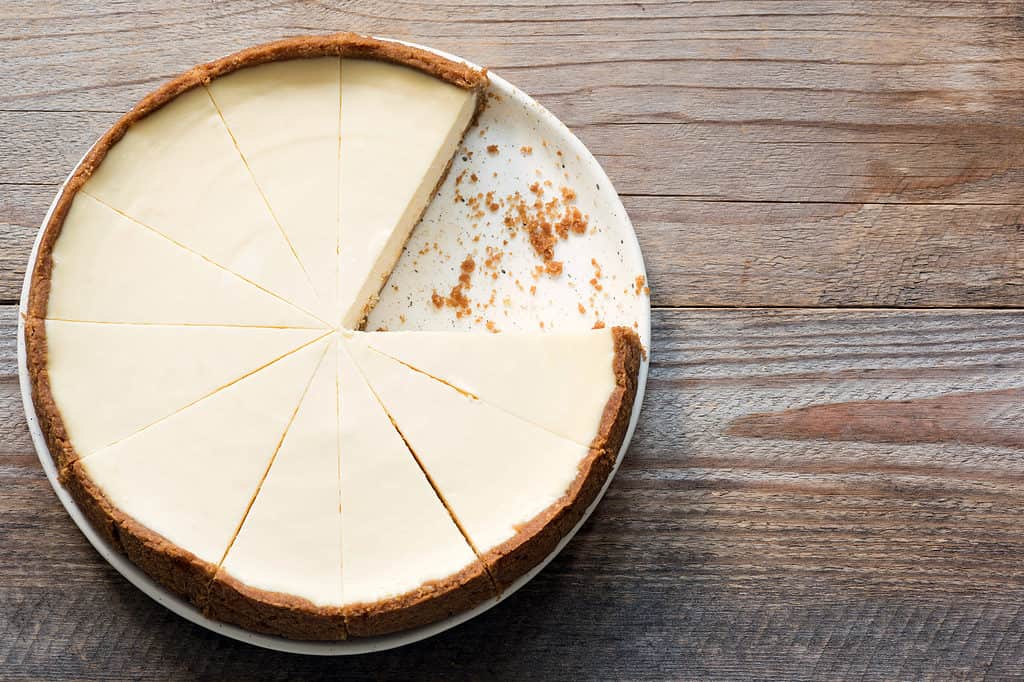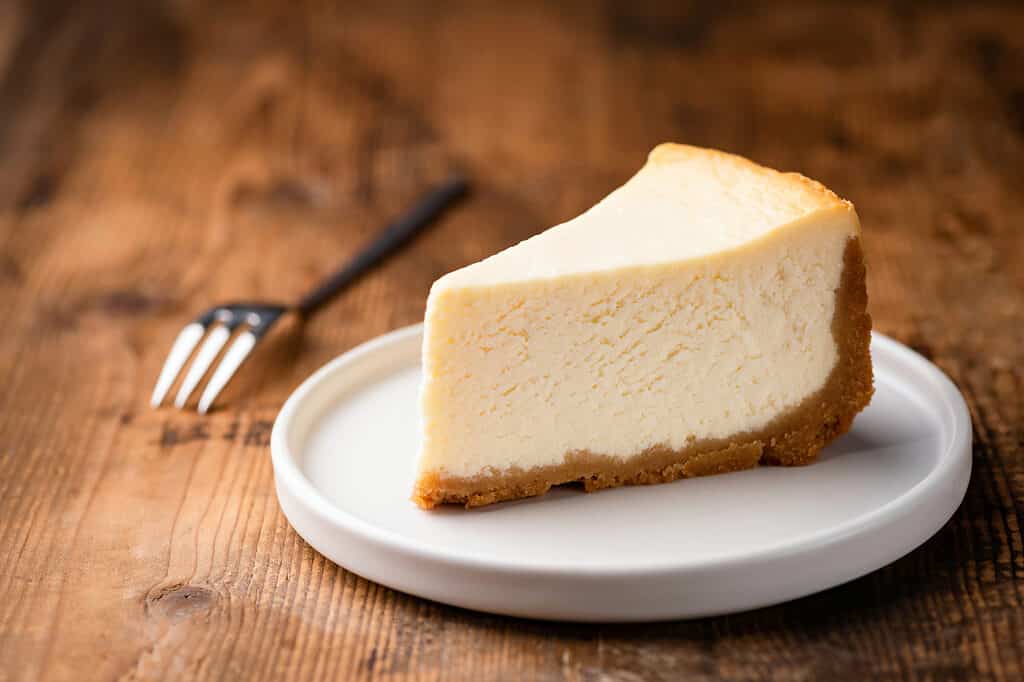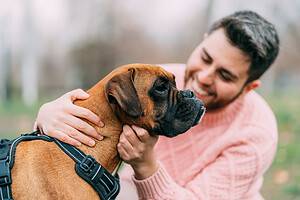Cheesecake is one of our favorite desserts! If you’re having a slice, you might wonder if your dog can share.
Keep reading to learn if dogs can eat cheesecake or not, the possible risks, and what to do if your dog gets into it behind your back.
Can Dogs Eat Cheesecake?

Cheesecake can be dangerous for dogs, especially in large amounts, because it contains excess fat.
©iStock.com/Arx0nt
Unfortunately, cheesecake can be dangerous for dogs, especially in large amounts, because it contains excess fat. Fatty foods can cause pancreatitis. Cheesecake also often contains toxic ingredients like the sweetener xylitol, chocolate, macadamia nuts, or raisins.
You’re likely better off keeping the cheesecake to yourself for these reasons and putting it far out of your dog’s reach.
The Risks of Cheesecake for Dogs
Xylitol
Xylitol is a sweetener that’s typically used to replace sugar. It can also be called birch sugar or wood sugar.
Xylitol causes a dog’s pancreas to produce more insulin, which decreases its blood sugar, causing hypoglycemia. This can occur as quickly as 10–60 minutes and is life-threatening.
If your dog eats cheesecake that contains xylitol, rush it to the nearest emergency veterinary clinic.
Excess Sugar and Fat
All cheesecake contains excess sugar and fat that dogs don’t need, and that can harm them–especially in large amounts. While a bite isn’t likely to hurt (assuming the cheesecake doesn’t contain any toxic ingredients), it also isn’t going to be healthy for your dog.
Pancreatitis
Fatty foods like cheesecake can cause pancreatitis or inflammation of the pancreas. This condition is serious and can be deadly, especially if your dog doesn’t get treatment.
Call your nearest emergency vet clinic if your dog displays symptoms of pancreatitis after eating cheesecake. These include:
- Nausea, repeat vomiting
- Fever
- Lethargy
- Abdominal pain
- Diarrhea
- Decreased appetite
- Increased thirst
Chocolate
Chocolate is one of the most well-known toxins for dogs. Fortunately, though, it rarely kills them. However, it can make dogs quite sick.
The amount of chocolate it takes to make your dog sick depends on several factors, including the type of chocolate and the size of your dog. Dark chocolate is the most dangerous, while white chocolate is much less of a threat.
Symptoms of chocolate poisoning include:
- Vomiting
- Diarrhea
- Increased thirst and urination
- Panting
- Restlessness
- Increased heart rate
- Tremors
- Seizures
- Heart failure
It’s always better to be safe than sorry. If your dog eats cheesecake that contains chocolate, contact your veterinarian or a pet poison hotline for help.
Tell the vet exactly what your dog ate, how much, and if it is currently showing symptoms.
The vet might suggest you bring your dog in for treatment or monitor it at home. If you do monitor your dog at home, call again if you notice new or worsened symptoms.
Macadamia Nuts
Macadamia nuts can cause severe poisoning symptoms in dogs, including:
- Weakness
- Depression
- Vomiting
- Lack of coordination
- Tremors
- Fever
Symptoms usually present within 12 hours and generally last around 48 hours. If your dog eats cheesecake containing macadamia nuts, call a veterinarian or pet poison hotline for guidance.
Raisins
Raisins are very toxic to dogs and can cause the following symptoms:
- Vomiting
- Lack of appetite
- Lethargy
- Diarrhea
- Kidney damage
If your dog eats raisins, bring them to the emergency veterinarian or your primary vet if available. Don’t wait for symptoms to present because symptoms like kidney damage cannot be seen from the outside.
Severe poisoning won’t be noticeable until around 24–48 hours after your dog has eaten raisins, and by then, it will have sustained significant kidney damage.
The longer your dog waits for treatment, the more damage can be done to the kidneys, worsening its prognosis. This can lead to kidney failure and death.
What To Do if Your Dog Eats Cheesecake

Some cheesecakes contain ingredients that are toxic to dogs.
©iStock.com/Arx0nt
The first thing to do if your dog eats cheesecake is to look at the ingredients list. Look for anything that’s toxic to dogs, including the ingredients listed above–xylitol, chocolate, macadamia nuts, and raisins.
If the cheesecake contains toxic ingredients, call a veterinarian or pet poison hotline. Depending on the toxin, you may need to see an emergency veterinarian immediately. No matter what, it’s good to call and get advice from a professional who can tell you if your dog needs to be seen.
Waiting for symptoms to present can mean risking your dog’s life, particularly if it has eaten cheesecake containing xylitol or raisins.
If the cheesecake doesn’t contain toxic ingredients, monitor your dog for symptoms of pancreatitis, which are listed above. See a veterinarian immediately if your dog shows symptoms.
Can Dogs Eat Cheesecake Crust?
Cheesecake is dangerous for dogs–but what about just a bit of the crust?
Unfortunately, the crust also comes with risks. Typically, cheesecake crust is made of graham crackers, which may contain xylitol.
It also contains a lot of sugar, which likely won’t hurt your dog in small amounts but isn’t healthy. Of course, if the crust is made of chocolate, you definitely shouldn’t share it with your dog.
Up Next:
The photo featured at the top of this post is © Jaromir Chalabala/Shutterstock.com
Ready to discover the top 10 cutest dog breeds in the entire world?
How about the fastest dogs, the largest dogs and those that are -- quite frankly -- just the kindest dogs on the planet? Each day, AZ Animals sends out lists just like this to our thousands of email subscribers. And the best part? It's FREE. Join today by entering your email below.
Thank you for reading! Have some feedback for us? Contact the AZ Animals editorial team.






